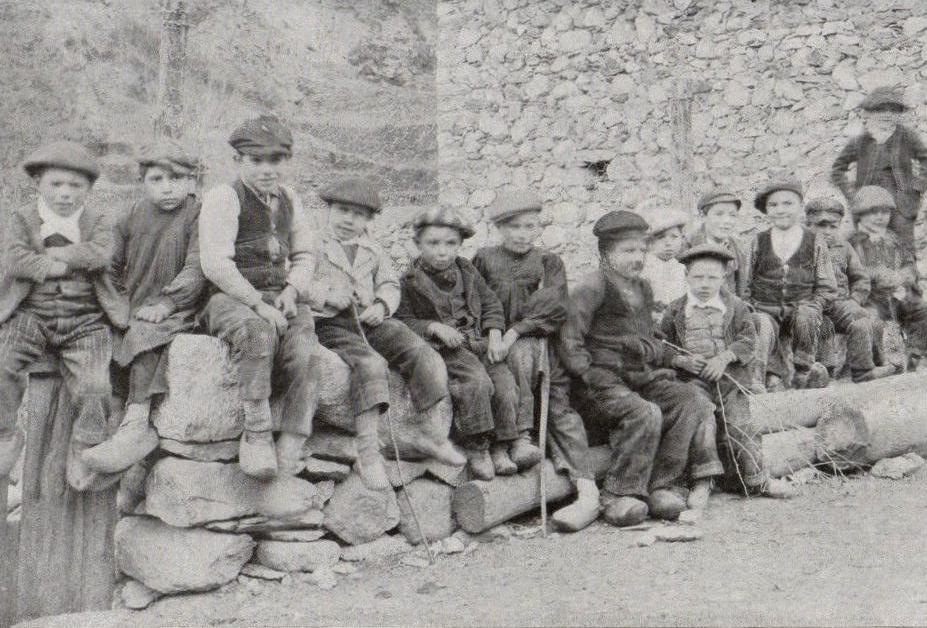
Andorra

Figure 1.--At the time of World War I, Andorra was still an isolated and poor principality set deep in theceastern Pyrnnes with few contacts beyond the neigboring regions of France and Spin. Here we see some Andorran boys in 1918. Notice the wooden clogs. Also notice that all the boys are wearing long pants, European boys this age generally wore knee pants, a reflection of the still prevalent isolation of the Principlity.
|
|
Andorra is one of Europe's micro states, tucked away in the eastern Pyrenees between France and Spain. The capital is Andorra la Vella. The principality dates back to the middle ages. Charlemagne reportedly granted a charter to the Andorran people as a reward for fighting the Moors who at the time had invaded and controlled most of Spain. The first verifiable records show the principality being chartred (988). The principality as it is now constituted was formed (1278). Andorra since the middle ges has been governed by two co-princes, a rare arrangement even during medieval times. The Spanish co-prince is the Roman Catholic Bishop of Urgell. The French co-prince eventually became the King of Navarre and than the king of France. With the creation of the Third Republic, authority fell on the the President of France. There were many principalities like Andorra scatered around Europe in the early-Middle ages. Almost all were eventuallu subsummed into the forming unified nation states. We suspect have French and Spanish co-princes is why Andorra maintained its independence. Andorra declared war on Germany during World War I, but did not participare in the fighting. Andorra during World War II was caught between German-occupied France and Francoist Spain, but was generally controlled by the Spanish and remained neutral. After the fall of France German occupation was prevented when the Spanish Civil Guards occupied the country (1940). A Sonderstab F (Special Staff F), a processing station, was set up for Spanish volunteers for the Blue Division. Andorra became an important smuggling route between France and Spain. Jews escaped the Germans and Vichy authorities in France by reaching Spain through Andorra. Andorra at the time was occupied by the Spanish. With the Allied invasion of France (1944), cut off German troops in southern France sought refuge in Andorra. They were disarmed and interned by the Spanish authorities. The Andorran people mostly speak Catalan because the Principality borders on the Spanish province of Catalonia. Most Andorrans generally understand French and Spanish which are both related to Caltalan. Andorra had for centuries an economy similar to the surrounding regions of France and Spain. As a result of its isolation, the Principality lived for centuries outside the European mainstream with few contacts betound the neigboring regions of France and Spain. With the prosperity that came with Europe's economic expansion after World War II, this began to change. Andorra is today a prosperous country involved in the mainstream of European life. The primary industry is now tourism, over 10 million tourists visit Andorra annually. The attractions are shopping and a range of outdoor nature activities in the mountaneous countryside such as skiing. And like several other European micro-states, there is a financial industry based on tax haven policie. Since Spain joined the EU, there has been a EU effort to limit tax havens. Andorra has not joined the EU, but because it is so small does not have irs own currency, but uses the Euro. The pricipality is notable for the high life expectancy.
HBC

Navigate the Boys' Historical Clothing Web Site:
[Return to the Main European country page]
[Introduction]
[Activities]
[Biographies]
[Chronology]
[Clothing styles]
[Countries]
[Topics]
[Bibliographies]
[Contributions]
[FAQs]
[Glossaries]
[Images]
[Links]
[Registration]
[Tools]
[Boys' Clothing Home]
Created: 12:38 AM 12/2/2014
Last updated: 12:38 AM 12/2/2014



